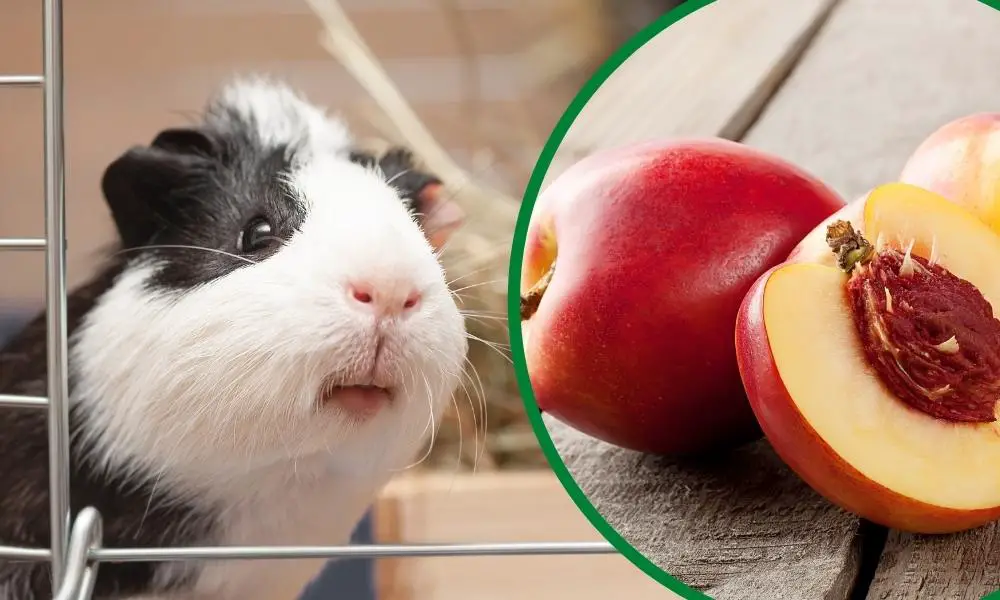Nectarines are juicy fruits we enjoy eating raw or even prepared as jams. Due to its great taste, you might want to offer some to your guinea pigs.
As a guinea pig owner, you need to be sure it’s a safe fruit to include in your guinea pig’s diet. Maybe you’re wondering– can guinea pigs eat nectarines?
Absolutely! Guinea pigs can eat nectarines. These fruits contain vitamin C, A, K, fiber, potassium, and many other healthy nutrients.
A fruit with this nutrition is just a healthy addition to your pet’s diet.
However, you can only feed in moderate amounts due to the high amount of sugar it has. Additionally, your cavy should only have it a few times a week, about 1-2 serving days.
Now you know that nectarines are a safe addition to your pet’s diet, you need to know the right parts to feed them.
So, your next question may be – What parts of the nectarine can you feed to guinea pigs?
Let’s find out…
Table of Contents
What Part of the Nectarine Can You Feed to Guinea Pigs?
There are other parts of this fruit to consider, such as the skin, seeds, and leaves. Let’s look at them below to know if you can also offer them to your cavy.
Can Guinea Pig Eat the Skin of Nectarine?
Yes, guinea pigs can eat the skin of nectarine. They are soft for them to chew. It is also tasty and guinea pigs will like it.
Nectarine skin is filled with fiber, vitamin C, and many other important nutrients. However, make sure you wash them very well before feeding them to your guinea pigs.
Can Guinea Pigs Eat Nectarine Seeds?
Not at all! Guinea pigs cannot eat the seeds of nectarine. Seeds are generally not good for guinea pigs as they could cause choking hazards.
However, nectarine seeds are not an exception to this. So, scoop them out when preparing nectarine treats.
Can Guinea Pigs Eat Nectarine Leaves?
A big NO! You shouldn’t let your guinea pig eat nectarine leaves. This fruit is a stone fruit just like cherries, plums, apricots, peaches, etc.
The leaves of stone fruits, like nectarine, contain poisonous chemical substances that are bad for your guinea pigs’ health.
So, leave them out when serving nectarine treats to guinea pigs.
How Much Nectarines Should I Feed to Guinea Pigs?
Serve only a small cube of nectarine to guinea pigs. It should be about an inch in size. Large chunks of this fruit are too much and would end up causing problems for your cavy.
The sugar in it and many other nutrients can harm your guinea pigs when they get too much of them. So, you need to keep things moderate by serving nectarine in bits.
Also, it’s very important to introduce this fruit treat slowly into your guinea pigs’ diet.
Let them start eating this new fruit bit by bit till you’re sure they’re fine eating them.
Pro Tip: Offer nectarines that are even smaller than the recommended sizes to your cavies. It should be smaller than an inch.
Check for any changes in their behavior, especially their health. If they seem fine, you can go ahead and serve them the normal serving sizes.
However, if you spot any changes and reactions after they eat this fruit, feed them a smaller size next time.
You should only increase this size gradually as they get used to smaller ones.
Now you know how much nectarine to feed your guinea pigs at a time, you might also wonder – how often can guinea pigs eat nectarine?
How Often Can Guinea Pigs Eat Nectarine
The proper amount of days to feed your guinea pig’s nectarine is a day or two in one week. They can’t have nectarines every day. It’s very bad!
You should also give some gaps between these two serving days. This helps to keep things pretty safe. See the table below…
| DAILY SCHEDULE | |
| Monday | Feed nectarine |
| Tuesday | Skip |
| Wednesday | Skip |
| Thursday | Skip |
| Friday | Feed nectarine |
| Saturday | Skip |
| Sunday | Skip |
However, let’s look at the nutritional facts of nectarines per 100 g serving below.
Nutritional Facts of Nectarines
| Nutrients | Amount Per 100 g |
| Fiber | 1.7 g |
| Carbs | 10.55 g |
| Calories | 44 Kcal |
| Vitamin C | 5.4 mg |
| Vitamin A | 17 mcg |
| Vitamin E | 0.77 mg |
| Vitamin K | 2.2 μg |
| Protein | 1.06 g |
| Potassium | 201 mg |
| Phosphorus | 26 mg |
| Calcium | 6 mg |
| Magnesium | 9 mg |
| Fats | 0.32 g |
Benefits of Feeding Nectarines to Guinea Pigs
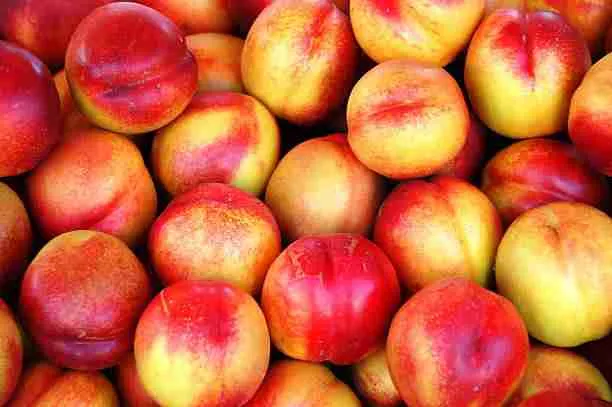
Your guinea pigs won’t just enjoy the taste of nectarines, but also lots of benefits too. Here are the health benefits your cavy will get from eating nectarine treats.
Boosts Immunity
Nectarines contain vitamin C, A, and many other antioxidants that help to keep your cavy immune to many diseases.
A common disease that guinea pigs suffer from is scurvy. It happens when they lack vitamin C in their bodies.
Too bad! Guinea pigs’ bodies cannot produce vitamin C. However, nectarines can help as they have lots of them.
So, feeding your guinea pigs nectarine treats will give them the immunity boosters they need to stay healthy and fight different diseases that may come up.
Improves Vision
Vitamin A is also a well-known sight booster aside from being a strong antioxidant. Vitamin E also helps to improve vision.
Good news! Nectarines have these two vitamins. So, they will both help to keep your guinea pigs’ sight in good condition.
Older guinea pigs normally experience poor vision. This is why foods with enough sight boosters are very important for them.
So, offering them this fruit treat is a good way to help them maintain normal vision.
Helps in Digestion
You’ll find fiber in nectarine that helps your guinea pigs in digesting other foods.
It’s a general problem for guinea pigs to have a weak digestive system. This is why they need help from food rich in fiber.
The dietary fiber in nectarines, both soluble and insoluble, helps to break down foods they eat with ease. Also, they promote good bowel movement.
This fruit treat will help prevent problems associated with digestion, such as indigestion and constipation.
Keeps Teeth And Bones Healthy
You’ll find calcium, magnesium, and phosphorus in nectarines. They all help to build strong bones and teeth.
Guinea pigs’ teeth need to be in good condition because they chew a lot. Plant foods can’t digest with ease. Your cavy has to grind them very well to ease the process.
This is common with herbivores. So, weak teeth would be a problem for your little pet.
Their bones need to be strong enough to support their weak bodies. when their bones are weak, they can easily fracture and that won’t be good for your pet.
Improves Cardiovascular Health
Nectarines have potassium in it that helps to lower high blood pressure. When your guinea pigs’ blood pressure goes up, it can be very bad for their heart.
Potassium also helps to contract and relax your guinea pigs’ heart muscles properly. This will promote a good heart rate and good breathing.
Moreover, as a low-fat and cholesterol-free fruit, your guinea pigs won’t have blockages in their blood vessels. So, blood will be able to flow freely to and from the heart.
Your guinea pigs can eat nectarine treats and stay far from heart-related issues.
Promotes Healthy Weight
Feeding your guinea pigs low fat and cholesterol-free diets is a good way to keep their weight in check. Good news! Nectarines have no cholesterol and are also low in fats.
So, as long as you offer this fruit treat to guinea pigs in moderation, you don’t need to worry about your cavy gaining unhealthy weight.
Helps in Hydration
Water is almost everything about this juicy fruit! This is good news for guinea pigs as they can stay hydrated just by eating these fruit treats.
Many vital organs in their body need water to work well. So, it’s very bad if your guinea pigs lack it. It can bring about many health issues for them.
Most guinea pigs don’t like to drink water a lot. This can be bad for their health, especially when they don’t get the amount of water their bodies need daily.
Also, during summer, offering them juicy fruit treats like nectarine will help keep dehydration far from your cavy.
Speeds Up Wound Recovery
The vitamin K in nectarines can help your guinea pigs whenever they get injured. This vitamin produces the protein that clots blood. Lacking this vitamin means your guinea pigs can bleed for long.
However, feeding your furry friends rich sources of vitamin K will help wounds close up faster and speed up the recovery process.
Health Risks of Nectarines to Guinea Pigs
Allergic Reaction
Guinea pigs can react badly to new food they try. So, guinea pigs can develop allergies to nectarines when they eat them for the first time.
However, this can’t happen to all guinea pigs. Some guinea pigs might experience it and some might not.
In addition, these reactions can be health issues. This is why nectarine should come into their diet gradually.
Digestive Issues
The fiber in nectarine is very important for your guinea pigs’ digestion. However, when your guinea pigs get too much fiber, it can do the opposite.
So, instead of helping digestion, excess fiber can cause serious digestive issues for your cavy. These could be bloating and gas.
Also, your guinea pigs can have loose stool, which is a bad bowel movement.
Obesity
Nectarines have low fats and no cholesterol in them. However, the high amount of sugar content in it has can cause obesity for guinea pigs.
This can only happen if your guinea pigs get too much sugar. That’s why moderation is important!
Feeding guinea pigs too much nectarine other than the normal serving amount can make them get excess sugar. This can then lead to obesity and even worse conditions, like diabetes.
Calcium Stones
Calcium is a very important nutrient for guinea pigs, especially in the development of teeth, bones, and even growth. However, younger guinea pigs need them more than older ones.
As guinea pigs grow older they don’t need a lot of calcium for them to get the benefits. Excess calcium from overfeeding can cause them several health issues other than benefits.
A common one is the kidney and bladder stones which calcium forms.
This situation can be very painful for guinea pigs, and in worse cases, they can cause infections and even death.
Chemical Poisoning
When you get nectarines from stores, they often have chemicals, like pesticides and herbicides on them. However, this is because of how they’re commercially grown.
These chemicals aren’t good for guinea pigs’ health. So, when you fail to wash nectarines before serving them to guinea pigs, your little pets can get sick.
How to Prepare Nectarines for Guinea Pigs
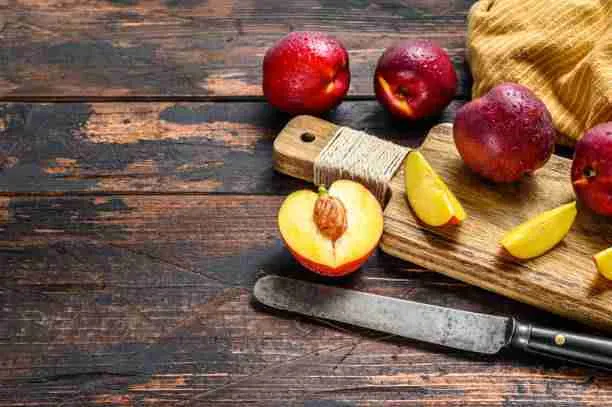
It’s important to prepare nectarine treats properly for your cavy before offering them guinea pigs. When you don’t do this, you can end up creating risks to your pet’s health.
You can follow these easy steps below to prepare these treats for your guinea pigs.
Step 1: Select Fresh Nectarine
Pick only fresh and ripe nectarines for the treats. Ripe ones are soft and with red skin throughout. Some spots might still have some yellowish on them.
They’re ripe and fine to use. However, you should avoid the nectarines with any greenish color on them. Avoid spoilt or leftover nectarines. It should always be fresh.
Step 2: Wash the Nectarine Very Well
You need to wash the nectarine before cutting them. Whether in a bowl of water or under running water, wash the nectarines thoroughly.
It helps get rid of the harmful chemicals, dirt, bacteria, and other things on the skin that can harm your guinea pig.
This is a very important step to take, especially if you’re serving the nectarine treat along with the skin.
Step 3: Remove Seeds From the Nectarine
After washing, you need to remove the seeds. You shouldn’t feed them to your cavy. So, with a spoon, scoop out all the seeds of the nectarine.
Step 4: Cut Nectarine into a Moderate Size
This part is where moderation comes in. First of all, you might need to peel the skin but only if your cavy doesn’t like it.
Cut nectarines into small cubes, about an inch in size, with a knife.
Step 4: Serve Nectarine to Guinea Pigs
Serve only one cube to each guinea pig. You should also do this on a clean surface.
Moreover, if you’re planning to serve nectarine in a cup of other healthy fruits, only use fruits that have low sugar. This helps to balance the sugar they’ll get.
Take Note!
When your cavy is done eating and there are some leftovers, you should get rid of them immediately. If it stays there for long, bacteria could grow on them.
It’s not safe getting into your little pet’s mouth again.
Other Healthy Alternatives of Nectarines for Guinea Pigs
You can just serve nectarines all the time. So, you need a replacement for the empty day you won’t be feeding them nectarine treats.
Additionally, for guinea pigs who might not like nectarines, you can serve them another healthy fruit.
However, here’s a list of healthy fruits like nectarine that you can choose from…
| Peaches | Tomatoes | Raspberries |
| Papayas | Mangos | Pineapples |
| Plums | cherries | Apricots |
| Apples | Tangerines | Watermelons |
| Pears | Grapes | Kiwi fruit |
| Bananas | Clementines | Blueberries |
| Cranberries | Cucumbers | Oranges |
Whichever fruit you choose, try to find out the proper serving amounts for your guinea pigs. Just like nectarines, your guinea pigs can only eat them in moderation.
This is because they may contain so much sugar and other substances that can harm your cavy in excess.
Frequently Asked Questions:
Can Guinea Pigs Eat Yellow Nectarines?
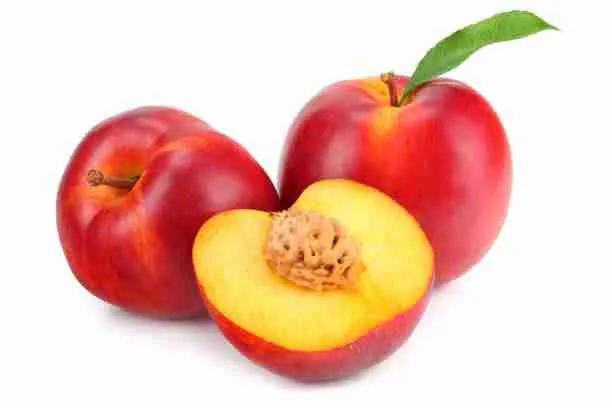
Of course! Guinea pigs can eat yellow nectarines. These are the most common kind of nectarines.
They’re so sweet, juicy, and with an acidic flavor. Your guinea pigs will love them! They make healthy fruit treats for your pet as they contain nutrients like fiber, vitamin, C, A, K, and many more.
However, stick to serving them in smaller amounts, like a small slice or cube. Wash them well before serving and offer them fresh and without seeds to your furry friends.
Can Guinea Pigs Eat White Nectarines?
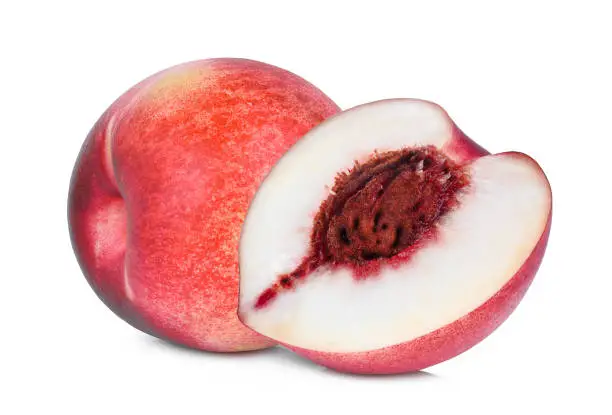
Yes, guinea pigs can eat white nectarines. This kind of nectarine has whitish flesh instead. Your guinea pigs can eat them along with the skin.
They also contain fiber, vitamin C, A, K, and many more nutrients you’ll find in yellow nectarines. They are sweeter than the yellow ones and are less acidic too.
White nectarine also has so much sugar in it, so you should serve it in bits. Also, remove the seed from this fruit before serving it to them.
Final Thoughts
To sum up, guinea pigs can eat nectarines. These fruits aren’t just tasty but also healthy for your guinea pigs.
It’s filled with important nutrients like vitamin C and fiber which your guinea pigs need every day.
Make sure you prepare them well to prevent any risks to your little pet’s health. In addition, never feed any cooked nectarine to your little pet.
It should always be raw, fresh, and ripe.
Remember to serve in bits, so don’t be tempted to feed your guinea pigs more even if they love the treats a lot.
I hope you learned a lot from this one. Please don’t hesitate to share it with other guinea pigs lovers!
